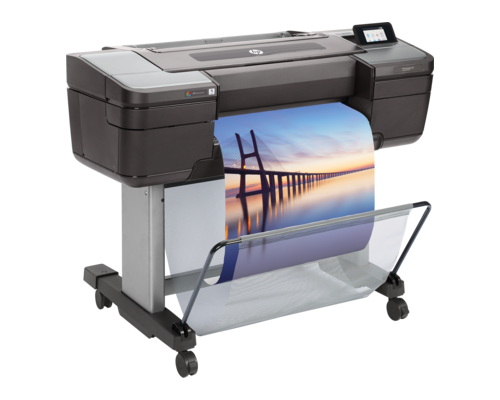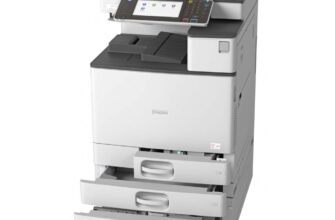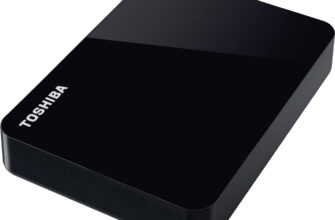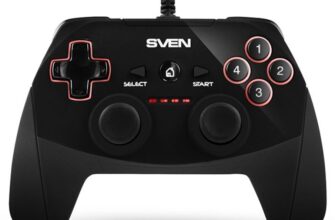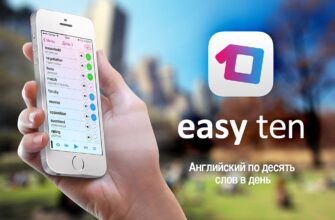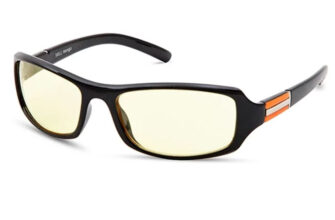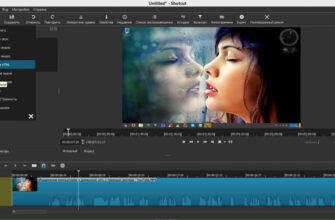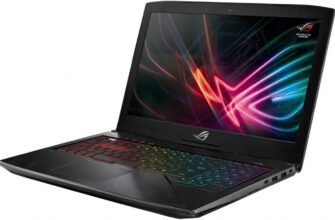Review of the best according to the editorial board. On the selection criteria. This material is subjective and does not constitute advertising and does not serve as a purchase guide. Before buying, you need to consult with a specialist.
Plotters are a special type of printing device that is used to produce a variety of products, from visual advertisements and large format engineering designs to brightly printed T-shirts. As such devices become more affordable, more and more operational printing companies acquire them for maintenance and operation. Our today's rating-review is devoted to the best plotters according to experts in four different categories – inkjet, solvent, textile and ultraviolet. And first, let's go through the main criteria for choosing a plotter suitable for certain purposes.
- How to choose a plotter
- Appointment
- Media format and type
- Ink type and printing technology
- Electronics, connection and additional functions
- Cutting
- Rating of the best plotters
- Best inkjet plotters
- HP DesignJet Z9 + 24 “Postscript (W3Z71A)
- Advantages
- disadvantages
- Canon imagePROGRAF iPF685
- Advantages
- disadvantages
- Epson SureColor SC-T3400N
- Advantages
- disadvantages
- Best solvent plotters
- Roland VersaStudio BN-20
- Advantages
- disadvantages
- Mimaki JV150-160
- Advantages
- disadvantages
- Best textile plotters
- Mimaki TS300P-1800
- Advantages
- disadvantages
- Epson SureColor SC-F2000
- Advantages
- disadvantages
- Best UV plotters
- Mimaki JFX200-2531
- Advantages
- disadvantages
- Mimaki UJF-3042 MkII
- Advantages
- disadvantages
How to choose a plotter
Initially, the term 'plotter' meant plotters – pen tablet devices that literally draw graphs and charts with great accuracy. With the improvement of inkjet printing technology and the expansion of the range of devices, any large-format printers (at least A2) with or without automatic cutting function began to be called plotters. Obviously, there are no household large-format printers-plotters – all this is professional equipment for commercial use – in operational printing enterprises, large advertising agencies, design bureaus, copy centers.
Appointment
The importance of certain characteristics and the presence of certain functions is primarily determined by the purpose of the purchased plotter. So, for example, if it is assumed that the lion's share of printouts will be photo wallpapers, banners, posters, billboards and other outdoor advertising, one type of device will do; if it is mainly planned to print complex infographics, vector images with small details, engineering drawings – you need to look after a plotter with just such a specialization.
In any case, there is a generally accepted conventional division of large-format printers-plotters into three groups: drawing (CAD / AEC), topographic (GIS) and art printing. For the first two categories, the accuracy and fineness of lines are important, therefore, the foreground will be the maximum resolution (optimal in most cases 2400×1200 dpi) and the minimum line thickness – no more than 0.01 mm.
All of these points should be clarified at the point of sale and require a detailed explanation, detailed consultation.
Media format and type
The size by the width of the media, or simply the format, is a key characteristic by which printers are classified as large-format. It is considered as such those models that are capable of printing on A2 format and more. A big advantage is the provided roll-feed capability, since paper and other media in rolls are significantly cheaper than cut sheets, all other things being equal. The maximum format directly affects the dimensions of the device and its cost.
The acceptable media type can vary greatly from model to model and is directly dependent on the printing technology and ink type. So, for example, most plotters print without problems on matte and glossy paper of various densities, slightly less capable of printing on polymer films and even less on textiles. There are no completely universal devices in this price range on the market, and future specialization must be carefully thought out in advance.
Some models of specialized printers are also considered plotters if they use the appropriate technologies – cutting, roll feeding, printing on special media, and so on. In the latter case, there may be even a smaller format – in our rating we will consider one such plotter of a slightly smaller format than A2, capable of printing on textiles, including ready-made T-shirts.
Ink type and printing technology
Inkjet printers, including large format printers, are distinguished by the principle of printing – thermal or piezoelectric. The difference between them is as follows. Piezoelectric ones for the most part give significantly better quality than thermal inkjet ones, but at the same time they are inferior to them in print speed and, on average, are significantly more expensive. On the contrary, thermo-jet ones are cheaper, faster, but all other things being equal (resolution, number of used basic colors, application of innovations), the picture quality is inferior to piezoelectric ones.
An extremely important point is the type of ink used. Ordinary water-soluble or pigment inks are the simplest and most affordable option, but they are also the least resistant to environmental factors, and such inks can be reliably applied almost exclusively to paper. If the printer uses solvent ink, this automatically means that the image will adhere firmly even to PVC media, it will not be washed away by rain and it will not fade in the sun. For efficient and high-quality printing on textiles, sublimation ink is used. A separate and very expensive type of ink is UV ink, which hardens when irradiated with an ultraviolet lamp or LEDs. This results in a fundamentally different character of the printed image.
Electronics, connection and additional functions
When printing large bitmaps at high resolution, the plotter has to process large amounts of data. In order for the device to cope with such processing without interruptions and detrimental to the quality of interruptions in the printing process, it is desirable that it be equipped with sufficient RAM for the range of tasks the buyer needs, a powerful processor and a hard disk. Such a full-fledged set is not always available in the basic configurations of plotters, so at the point of sale it is imperative to be interested in what tasks this or that configuration will cope with and whether it can be expanded.
In some cases, it makes sense to have additional functions and capabilities in the plotter – the function of printing on photo paper with sheets feeding from a separate tray, borderless printing, and so on.
In advance, you should inquire about the acceptable methods of connecting to the device. Some models are limited only by the local network interface – RJ-45, others in the appendage allow you to connect the device directly to a PC via USB, and some allow you to interact with the plotter via Wi-Fi and effectively use cloud services.
Cutting
An important function of the plotter is the availability of automatic cutting. In the minimum version, you need at least a knife to cut the roll media at the end of printing each block. A more advanced option is the contour shape cutting function. Its presence significantly expands the potential range of products produced by the plotter – stickers, curly flyers, cardboard souvenirs, and more. When choosing a contour cutting plotter, you should pay attention to two main parameters – cutting accuracy and pen pressure. The first determines what materials and what density the device will be able to cut qualitatively along the contour, and the second – how small details the plotter can cut. “Aerobatics” – the presence of an optical positioning sensor – if available, the plotter can cut along the contours and graphic marks, even if the workpiece itself was printed on another device.
Rating of the best plotters
| Nomination | a place | Name of product | price |
| Best inkjet plotters | 1 | HP DesignJet Z9 + 24 “Postscript (W3Z71A) | RUB 244 986 |
| 2 | Canon imagePROGRAF iPF685 | RUB 154 169 | |
| 3 | Epson SureColor SC-T3400N | RUB 148,000 | |
| Best solvent plotters | 1 | Roland VersaStudio BN-20 | RUB 556,224 |
| 2 | Mimaki JV150-160 | RUB 725 872 | |
| Best textile plotters | 1 | Mimaki TS300P-1800 | RUB 1,787,860 |
| 2 | Epson SureColor SC-F2000 | RUB 850,820 | |
| Best UV plotters | 1 | Mimaki JFX200-2531 | RUB 7,731,000 |
| 2 | Mimaki UJF-3042 MkII | RUB 1,390,559 |
Best inkjet plotters
Let's consider first of all printers-plotters of the most inexpensive price category. Their affordability is explained by the use of the simplest printing technology – inkjet (thermal or piezoelectric) using conventional water-soluble or pigment inks. Our experts suggest paying attention to three models from different manufacturers – Hewlett-Packard, Canon and Epson. All three examples are designed for maximum A1 sheet size and also support roll-to-roll printing. The type of media can vary – from matte paper to plastic film, and it is advisable to check this at the point of sale.
HP DesignJet Z9 + 24 “Postscript (W3Z71A)
Rating: 4.9
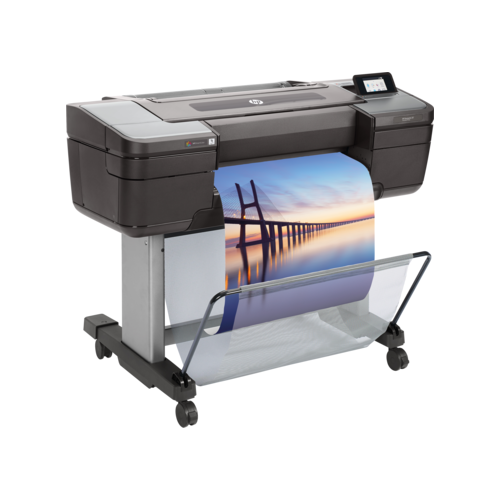
The first selection of the rating of the best plotters is opened by a large-format inkjet printer from the famous American company Hewlett-Packard. This is the most versatile and expensive device in the top three large format inkjet plotters.
The plotter was designed for floor placement – the printing module is placed on a special mobile trolley with wheels. Overall dimensions of the entire structure – 1293x998x695 mm, weight – 72 kg net and 102 kg in a package. Package dimensions – 1440 x 766 x 718 mm.
For operation, the device needs up to 100 W of electrical power, in passive mode – up to 32 W. The nominal noise during operation should not exceed 45 dB. When idle, the printer also makes a little noise – up to 33 dB. The control panel has a color touchscreen display.
Color printing on this model is carried out using thermal inkjet technology. As many as nine cartridges of 300 ml each with pigment ink and another one with auxiliary composition: magenta, yellow, cyan, chromatic red, photographic black, matte black, chromatic green, chromatic blue, gray, gloss enhancer take part in the formation of a high-quality image. The maximum resolution is 2400×1200, the minimum drop volume is 6 pl. Accuracy of lines within 0.1% error. The minimum line width is 0.02 mm.
This model implements several possibilities for using media at once. So, the minimum permissible sheet format is 210×279 mm, the maximum is 610 x 1676 mm. Sheets can be fed from the top or from the back. Rear feed is designed primarily for the heaviest and hardest media (the plotter is capable of printing on cardboard 500 grams per square meter. The minimum paper grammar is 80 gsm). Another option is roll media from 279 mm to 610 mm wide. In this case, another detail of the model becomes important – the automatic paper cutter. A special catcher basket under the printer in the space of the cart stand is used for neat stacking of the output prints. The maximum printing productivity reaches 55.7 square meters per hour.
Against the background of the outstanding characteristics of direct printing, the electronic hardware part of this model commands respect. So, as much as 4GB of RAM is installed here – a volume comparable to full-fledged personal computers and a 500 GB hard drive, in which 128 GB is automatically allocated to virtual memory to expand the RAM. Thus, the developers of the model did everything so that the plotter did not 'slow down' even when processing the most voluminous data sets for printing large-format images in high resolution.
The plotter is connected directly to the local network via a wire with a standard RJ-45 twisted pair interface. There are no other connection methods, such as Wi-Fi, but this should by no means be considered a disadvantage, this is a well-founded feature of professional-grade commercial equipment.
Additional functions and capabilities: web interface; PostScript support; direct printing; integrated processor Adobe PDF Print Engine. Branded drivers are written for operating systems Windows, Mac OS, iOS, Android.
The delivery set of the printer includes: a plotter, a set of test cartridges, a mobile stand-cart; basket-catcher for finished prints; spindle; instruction; setup poster; power cable; printheads. In addition to the above, the manufacturer recommends a set of original HP software for different systems: Applications Center, Color Center, Click, Partner Link Pay-per-use, PrintOS, Web JetAdmin.
Advantages
- professional level of the device;
- 9 pigment ink cartridges;
- gloss enhancer in the 10th cartridge;
- printing photos;
- cloud printing support;
- automatic cutter;
- mobile trolley support.
disadvantages
- no obvious shortcomings and systematic negative reviews were identified.
Canon imagePROGRAF iPF685
Rating: 4.8
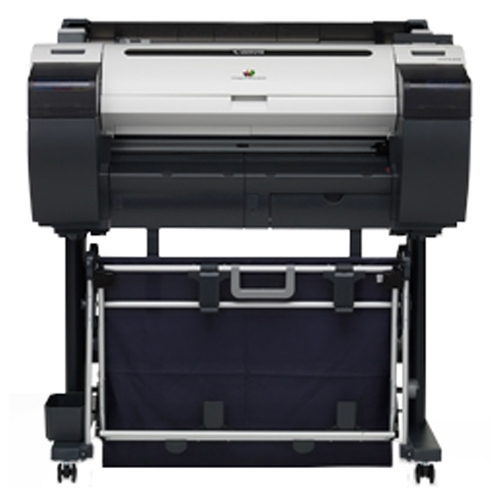
The second number in the first selection of the rating is the large-format printer of the famous Japanese brand Canon. This device is less functional and generally simpler than the previous model, but it is still capable of meeting all or almost all of the production needs of an operational printing enterprise. And with all this, this model is cheaper than the previous one by an average of 100 thousand rubles.
The design of this model is fundamentally identical to the previous one: the functional module is placed on a mobile cart with wheels, in the space of the cart under the printer there is a basket-catcher for finished prints. Dimensions of the entire structure – 997x1062x1100 mm, net weight – 56.9 kg, rated operating voltage – 140 W, operating noise – up to 47 dB, idle noise – 35 dB.
In this plotter, color rendering is already carried out on the basis of the standard four-color model with the only additional ink – matte black. Each ink has a separate reservoir with two capacities – 130 or 300 ml. The minimum drop volume is 4 pl. Black ink – pigment, color – water-soluble type. The maximum resolution is 2400×1200 dpi. There is a photo printing function and borderless printing. Estimated print speed for one color D-size print (24×36 inches) – 28 seconds.
We should also highlight the elegant solution of the developers of this plotter regarding the use of ink. There are two options for ink tanks – 130 or 300 ml, and you can independently decide what volume is best for you based on the most likely workload. In addition, there is a possibility of 'hot' replacement of cartridges due to the presence of intermediate reservoirs between each cartridge and the printhead.
Parameters of recommended and permissible consumables: sheet width – from 203.2 to 914 mm; roll width – from 254 to 610 mm; carrier thickness – not less than 0.07 and not more than 0.8 mm; outer roll diameter – up to 150 mm; maximum print length – 18 m.
The electronics in this model are already more modest than in the previous one, but they completely cope with their direct tasks. There is 256 MB of RAM installed, and the hard drive is not much behind in terms of volume from the above-described solution – 320 GB. You can connect to the device not only via a local network to the RJ-45 interface, but also directly from a PC via USB 2.0. The standard set of drivers supports the Windows and Mac OS family systems. PostScript is not supported.
Advantages
- hot replacement of the cartridge;
- quality of CAD graphic materials;
- convenient work in cloud environments;
- intuitive software for direct printing and sharing;
- accounting tools.
disadvantages
- not found.
Epson SureColor SC-T3400N
Rating: 4.7
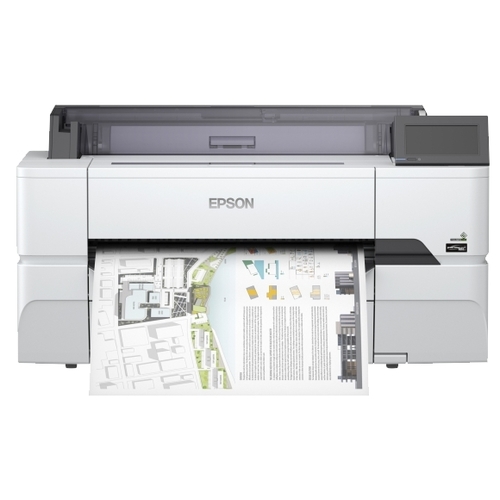
Rounding out the top three inkjet devices in the ranking of the best plotters according to the version is the model of the SureColor line from Epson. This is already a desktop form factor, although, if necessary, you can easily order the same stand-trolley as in the two above-mentioned models. The printer is comparable in price to the previous Canon model.
Plotter dimensions – 1080x585x668 mm, net weight – 49 kg. In operation, it consumes significantly less energy than either of the two models described above – 38 W at load and no more than 13 W at idle. Noise during operation does not exceed 50 dB. The control panel has a 3.4 ”color display. Printing technology – piezoelectric inkjet.
Color printing here is based strictly on the 4-color standard model without additional inks and auxiliary compositions. Accordingly, four cartridges are used. The minimum drop volume is 4 pl. The maximum resolution is 2400×1200. There is a photo printing function and borderless printing. Cartridge volume – 110 or 350 ml. Print speed – 25 sec per A1 print. The first print comes out after 25 seconds.
This plotter is designed only for printing on paper as media. The permissible thickness – not less than 0.05 mm and not more than 0.3 mm – applies to both sheet media and roll media. The maximum roll diameter is 170 mm.
RAM is installed here in the volume of 1GB, connection is possible via a local network, USB 3.0, as well as via a wireless Wi-Fi channel of the 802.11n standard. Direct printing and AirPrint are supported. There is no PostScript support. Official drivers – for operating systems Windows – families, Mac OS and iOS.
Advantages
- relatively affordable price;
- print speed;
- available consumables;
- low power consumption.
- wireless connection.
disadvantages
- no obvious flaws were found.
Best solvent plotters
The second group of plotters in our rating is a device that uses a special type of ink for printing – solvent. They are based on the solvent itself – an organic solvent that is a mixture of light hydrocarbons. Being chemically aggressive, the solvent in the ink composition, getting on the image carrier during printing, partially dissolves the top layer, deeply and firmly penetrates the surface, and then evaporates quickly. The resulting image is thus resistant to moisture, ultraviolet rays and a number of other environmental factors. This makes inkjet printing possible even on PVC-containing substrates with reliable image fixing. Solvent ink is only used in piezoelectric printers.
Currently, the most prominent solvent printer manufacturers are the Japanese companies Mimaki and Roland. It is their products that experts recommend, and we will consider two of the most successful models.
Roland VersaStudio BN-20
Rating: 4.9

The first to describe the plotter is 'simpler' and cheaper. This is the representative of Roland's bright VersaStudio line. Its cost on the Russian market is about half a million rubles, depending on the point of sale and a specific batch.
The dimensions of the device are largely dictated by the maximum possible media format – A1, and are 995x291x585 mm. Net weight – 35 kg. These parameters are almost the maximum limit for desktop installation, and Roland engineers have managed to implement this form factor. In operation, the printer consumes up to 90 W of electricity and no more than 5.5 W when idle. Noise during operation should nominally not exceed 62 dB, in a simple unit is also not silent – 42 dB.
The plotter generates full-color images on the basis of the standard CMYK model with an additional fifth Mt cartridge to reproduce the 'metallic silver' shade. The maximum resolution is 1440×1440. There is a photo printing function. Recommended ink is Roland ECO-SOL MAX or FPG Aqueous.
The following types of media can be used in this device: paper, photo paper, photo wallpaper, polymer film, poster paper, vinyl mesh, mural and eco-mural, various materials for banners. The model is structurally optimized for roll feed, the maximum roll thickness in diameter is 150 mm and weight is no more than 6 kg. The acceptable media width is 150 to 515 mm. Maximum thickness 1 mm with backing.
One of the important aspects of the functionality of this model is the function of page and contour cutting. The acceptable cutting media thickness is 0.4 mm with a liner or 0.22 mm without a liner. Cutting width – up to 480 mm. Speed - 150 mm / s.
The plotter is connected to the PC via the USB 2.0 interface. Standard drivers only support OS family Windows. PostScript is not supported.
The delivery set includes a plotter, cords – power and USB connections, a knife and holder, VersaWorks software, instructions.
Advantages
- the fifth color is silver paint;
- automatic contour cutting;
- a high resolution;
- consistently high quality using original ink.
disadvantages
- not found.
Mimaki JV150-160
Rating: 4.8
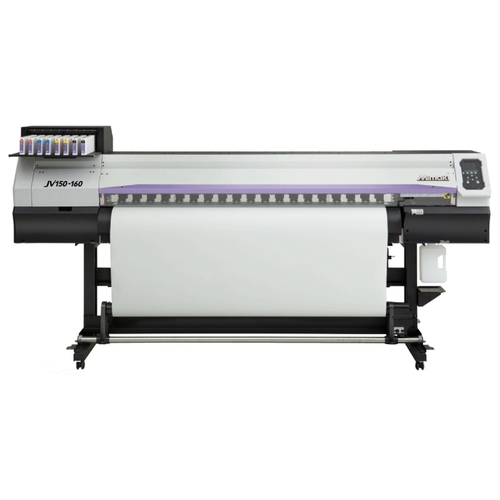
And the second solvent plotter in our ranking is a model that is twice as large and much more functional. The price, of course, is more expensive than the above-described Roland, but not several times, but by 50-60% on average at points of sale. It should be understood that despite the impressive price, this series is considered a budget alternative to Mimaki JV300.
The physical parameters themselves speak of the professional, practically industrial accessory of the device: dimensions – 2775x1392x700 mm, net weight – 185 kg. Power consumption is commensurate with rather powerful household heaters – 1920 W, but in the context of capabilities and performance, such costs are quite justified – they allow you to quickly and efficiently print on A0 format media.
The maximum resolution, which the plotter is capable of printing, is 1440×1440 dpi. Here, for a complete understanding, you need to take into account a number of important points that the developers of the device have provided in its functionality. So, for example, it is possible to install and use two options for sets of cartridges by color: 4 colors of the standard CMYK model or 6 colors, where, in addition to 4 main colors, light cyan and light magenta are also used. The functionality allows you to add orange and light black. In addition, a number of Mimaki's patented innovations are implemented, such as the Advanced Pass System (imitation of gradation printing to eliminate the visibility of non-pass mismatches), a three-stage intelligent media heating system, compensation for faulty nozzles and other features that allow you to get an image of exorbitant quality and color realism.
The plotter supports printing on paper and transparencies, including roll feed. The maximum permissible media thickness is 1 mm and the width is 1610 mm. The printing speed reaches 56.2 square meters. in hour. When using the standard four-color model, the device can be operated from paired cartridges – in the event of an empty one, the plotter automatically switches to another cartridge of the same color, and the empty one can be replaced without stopping printing. CISS can be optionally installed with volumetric reservoirs of several liters for each color.
You can connect to the plotter over a network via RJ-45 or directly to a PC via USB 2.0. Official drivers have been released for family operating systems Windows. PostScript is not supported.
In general, the plotter's capabilities allow producing a wide variety of graphic products: high-quality outdoor advertising, art reproductions, exhibition graphics, interior decor, car styling elements, POS materials and much more.
Advantages
- hot replacement of cartridges;
- auto cutter for paper;
- CISS is optional;
- innovative technologies and approaches to maximize print quality;
- performance;
- professional level for a relatively affordable price.
disadvantages
- no contour cutting.
Best textile plotters
The third category of devices in our rating is plotters, which are structurally and conceptually oriented for printing on a variety of textile media. In such printers, a special type of ink is used – dispersion or sublimation, a variety of techniques and technologies are used to make the image realistic and at the same time resistant to the manifestations of environmental factors – solar ultraviolet, moisture, negative temperatures and their drops. With the help of textile printers they make: flags, pennants, standards and other symbols; tablecloths and bed linen; curtains and upholstery fabric; stretch ceiling; outdoor advertising; clothing for sports competitions, promotions, for everyday wear (T-shirts with prints); various decorations.
Mimaki TS300P-1800
Rating: 4.9
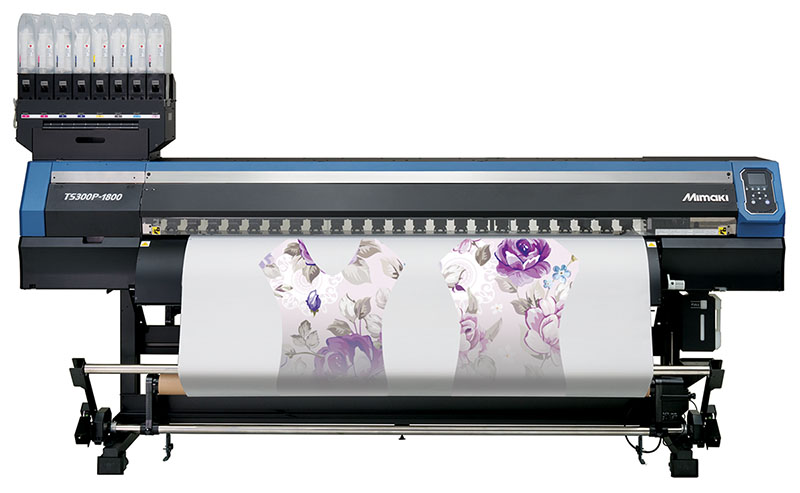
First, consider the powerful professional wide-format model produced by the specialized Japanese company Mimaki. This is a real record holder in terms of the maximum permissible media format.
The dimensions of the device in no way leave any chances for an office installation – 3200x1857x850 mm. The unit also weighs more than decently – 213 kg and consumes 1.92 kW of power in operation. The package includes a stand for floor installation. Connection – via USB 2.0 or Ethernet.
The maximum media sizes for this model even exceed the A0 dimensions – the print width is 1940 mm. Sheet feed is not provided – only roll feed, and this is more than rational with such a huge format. The maximum permissible roll diameter is 250 mm, the maximum weight is 40 kg. For this model, it is permissible to use not only textiles as a carrier, but also polyester and various types of special paper – transfer, sublimation, for heat presses. Borderless printing is not available. There is an automatic rewinder for smooth transition from roll to roll and an automatic paper cutter. The limiting thickness of the carrier is 1 mm.
The plotter uses piezoelectric printing technology with sublimation ink type. The maximum resolution is 1040 x 1040. In draft mode, the print speed reaches 115 square meters. meters per hour. It is possible to use two color scheme options – 4 base colors of Mimaki brand inks – blue, magenta, yellow. the black; 6 basic colors – light blue and light magenta added to the listed four. The plotter 'by default' is equipped with a proprietary Mimaki Bulk Ink System 3 CISS, where a 2-liter reservoir is allocated for each ink color.
In this model, Mimaki engineers have implemented a number of improvements and innovations that allow to maximize print quality and its stability, minimize the likelihood of rejects, simplify the operator's work, etc. and unwanted direct contact with the print head. Auto Rewind ensures that media is fed evenly off the roll. The patented MAPS4 print control technology eliminates bending and uneven spot color blending by blurring the edges of the pass like a gradient. It also implements an improved technology for controlling the voltage wave on the piezo membrane of the head – drops are obtained with an ideal spherical shape.
Advantages
- print width;
- printing not only on textiles, but also on paper;
- speed;
- exceptional quality;
- effective use of innovation.
disadvantages
- no noticeable shortcomings and systematic user complaints were found.
Epson SureColor SC-F2000
Rating: 4.8
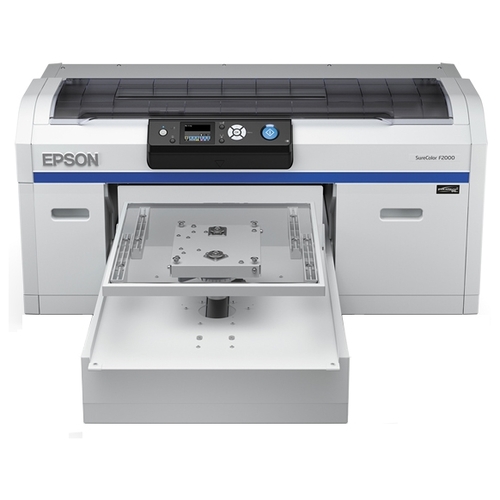
Now, as part of the rating of the best plotters according to the version, we will consider a model for a highly specialized purpose – for creating prints on T-shirts and media similar in form factor. Our experts considered it necessary to pay special attention to this particular type of printer, since the business model, implying earnings on T-shirts with prints, has been and remains relevant and in demand.
The printer prints on fabric or ready-made T-shirts. The width of the print field is 406 mm. This is slightly smaller than the A2 format, but there are modifications of the same model with a print margin extended to 420 mm. With this format, the dimensions of the device are 985x490x1425 mm, the net weight is 82 kg. These options allow you to place the plotter on the table. For operation, it needs to be connected to a power supply with a consumption of up to 52 W. The noise level is low, comparable to ordinary household printers – up to 41 dB.
The plotter uses a piezoelectric inkjet printing principle with special ink. You can use two options for a set of ink cartridges: 4 colors according to the standard CMYK model or 5 colors where the complementary color is white. The purpose of the white color is obvious – for full reproduction of images on dark backgrounds. The volume of the ink tanks can also be different – 250 or 600 ml to choose from, depending on the intensity of the plotter operation.
Print quality is determined directly by the technical resolution – 1440×1440 dpi and the use of special innovative techniques, which are discussed below. The minimum drop volume is 21 pl. This is many times and tens of times more than in the case of other types of plotters, but for printing on cotton or any other base of T-shirts, a smaller volume will not provide adequate quality. Print speeds up to 88 seconds per T-shirt, depending on resolution.
The printer has quite a lot of RAM installed – 512 MB. There are two connection methods – a local network via the RJ-45 interface or USB 2.0 directly to a PC. Branded drivers are released only for operating systems Windows – families. PostScript is not supported.
Separately, it is worth emphasizing a number of important advantages of this model: the ability to print on 100% cotton or on mixed fabrics (minimum cotton content – 50%); media thickness – up to 25 mm – a special printing table is used, which can even be purchased separately if desired; the model has received Oeko-Tex 100 (Product Class 1) certification, which guarantees safety for all ages – from adults to babies; minimization of rejects due to the ink circulation system and effective automatic cleaning of the piezo head; Epson UltraChrome DG ultra-durable dye inks do not fade, crack, abrade, and are not afraid of washing; do not create a feeling of stiffness and 'sharp edges' when wearing clothes.
Advantages
- printing on cotton, synthetics and blended fabrics;
- large acceptable media thickness;
- environmentally friendly dyes safe for children;
- convenient and intuitive software.
disadvantages
- very expensive consumables.
Best UV plotters
The final category in our rating is plotters that print using so-called UV ink. The principle of applying the image here is based on the use of a special chemical composition of ink that is susceptible to ultraviolet radiation. Under the influence of a powerful UV lamp, the applied image quickly polymerizes. Thus, it becomes possible to print on a wide variety of substrates without additional processing. Polymerization under the influence of ultraviolet radiation is an irreversible process, therefore, images of UV plotters are not afraid of sunlight, moisture, or the effects of many aggressive chemical environments.
UV plotters are, on average, the most expensive machines when compared to plotters that work on any other principle. Their cost is mostly estimated at millions of rubles as of the end of 2019.
Mimaki JFX200-2531
Rating: 4.9
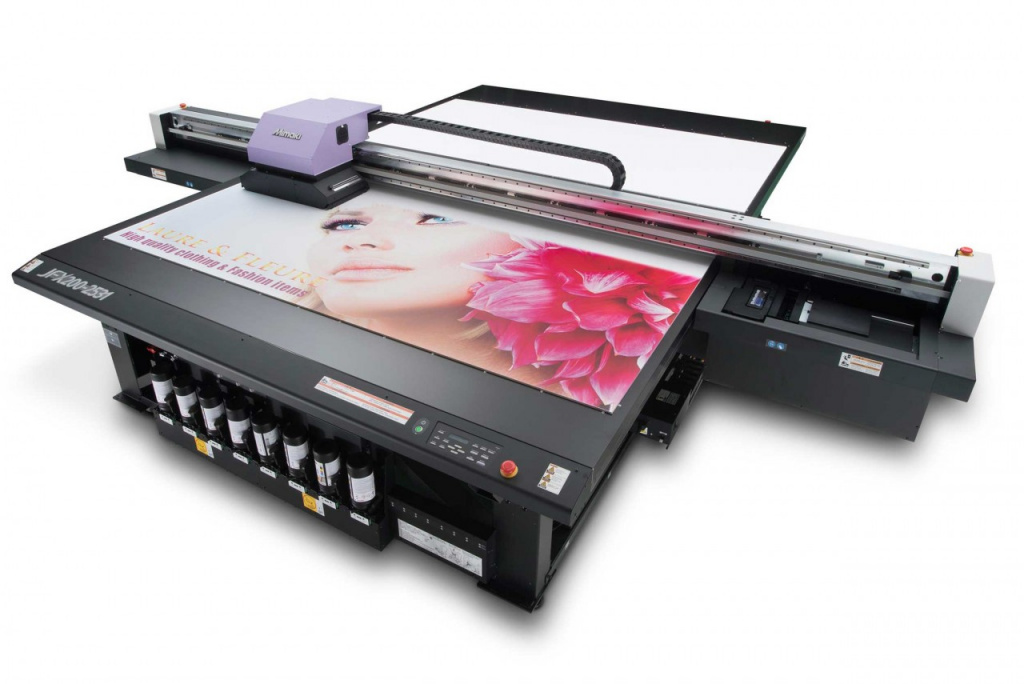
First of all, we will introduce you to the 'older' model, which has wide functionality and a number of additional features. The device is capable of printing on media in the largest possible sizes – A0 and larger.
The requirement of the device for power, voltage and stability of the power grid has been increased, and in the most serious way – a current with a voltage of up to 240 V and a power of up to 12 A. It is highly desirable to provide the plotter with an intermediate power link to protect against power and voltage surges. The dimensions of the device are impressive – 4290x4400x1250 mm, and even more so – the whole structure weighs almost exactly one ton. Power consumption – 4.8 kW!
This model has a printable area of 2500 mm (98 inches) with a nominal print area of 2500 x 3100 mm. Print speed – up to 25 sq. m per hour. It assumes only sheet feed, you cannot print on roll media. This seeming limitation is easily explained by a wide range of materials that are suitable as a base – acrylic, polycarbonate, PVC, glass, aluminum, metal, polyester, foam panels, styrene, wood, stone.
The plotter prints up to 1200×1200 DPI. There are three options of cartridge kits – 5, 6 and 8 colors. The basis is always 4 colors of the CMYK model with the addition of white, light cyan, light magenta. The maximum permissible thickness of the carrier is 50 mm, the maximum weight is 50 kg per square meter.
The ionizer is located at the rear of the unit and is shaped like an elongated 'Y' beam to reduce static electricity. The vacuum-type adjustable clamp has 4 clamping zones, which are separately regulated by special valves.
The device connects to the control workstation via USB 2.0. No network connection provided.
Advantages
- high-quality and reliable vacuum clamp;
- patented wavelength control technology;
- using the variable drop technique;
disadvantages
- no network connection.
Mimaki UJF-3042 MkII
Rating: 4.8
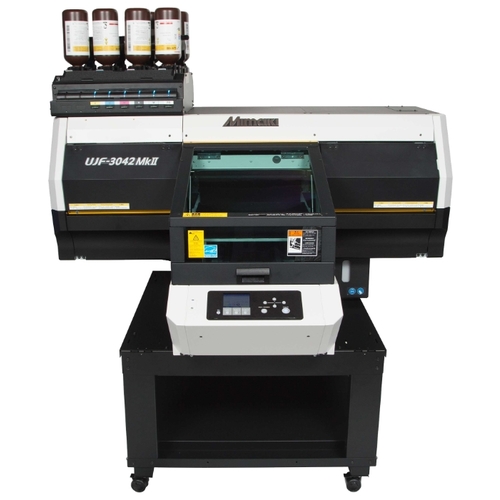
And the final device in the rating is a UV plotter of the same company – Mimaki. Our experts recommend this option to those who do not need a huge format. This plotter prints in A3 format.
Despite its much smaller format, this plotter is also designed for floor installation. But its special shape allows efficient use of space in the workshop / office. Its general dimensions are 1355x856x1290 mm, weight without packaging is 145 kg. In terms of power consumption, it needs 800 W and works quite quietly, as for this class of devices – 70 dB in operation and 55 dB in idle.
As for the media, there are the following restrictions: the size of the working field – 300 × 420 mm; carrier thickness – no more than 153 mm, weight of a 'pack' of material – no more than 5 kg; maximum print speed – 2.48 sq. meters.
This machine prints on a five-color primed model. Resolution up to 1200×1200 dpi. The capacity of the tanks is 500 ml or 1000 ml.
This model has no PostScript support and driver only for Windows. Connection – via USB and Ethernet.
Advantages
- convenient shape for confined spaces;
- relatively inexpensive;
- quality of the resulting image sufficient for such a price.
disadvantages
- no PostScript support.
Attention! This rating is subjective and does not constitute an advertisement and does not serve as a purchase guide. Before buying, you need to consult with a specialist.

